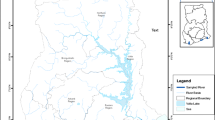Conclusion
The data reported here indicate that the presence of mercury in fish of relatively unpolluted Lower Coastal Plain streams results in accumulation of mercury by otter and mink which feed on these fish. Otter exhibit hair mercury levels which approach those at which symptoms of neurological disorders have been reported in humans suffering from mercurial poisoning (BIRKEet al. 1972). Subtle effects on behavior resulting from sublethal mercurialism could affect the reproduction and survival of certain populations of otter or mink. Possible sublethal effects of environmental mercury or other pollutants at trace levels on native animal populations deserve further study, since such information would be useful in formulating sound policies regarding discharge of pollutants under varying circumstances. Additional investigation is needed to determine the relative contributions of natural and man-caused mercury inputs to mercury levels observed in native wildlife species.
Similar content being viewed by others

References
BIRKE, G., A.G. JOHNELS, L. PLANTIN, B. SJOSTRAND, S. SKERFVING and T. WESTERMARK. Studies on humans exposed to methyl mercury through fish consumption. Arch. Environ. Health25, 77 (1972).
CUMBIE, P.M. and J.H. JENKINS. Mercury accumulation in native mammals of the Southeast. 28th Proc. Southeastern Assoc. Game and Fish Commissioners (1974, in press).
GEORGIA WATER QUALITY CONTROL BOARD. Mercury pollution investigation in Georgia, 1970–1971. 110p. Atlanta 1971.
HUCKABEE, J.W., F. CARTAN and G. KENNINGTON. Environmental influences on trace elements in hair of 15 species of mammals. U.S. Atomic Energy Comm. O.R.N.L.-T.M.-3747. 38p. Oak Ridge, Tenn. 1972.
JENKINS, J.H. and T. FENDLEY. The extent of contamination, detection and health significance of high accumulation of radioactivity in southeastern game populations. Proc. Southeastern Assoc. Game and Fish Commissioners22, 89 (1968).
JOENSUU, O.I.. Fossil fuels as a source of mercury pollution. Science172, 1027 (1971).
LAMBOU, V.W. Problem of mercury emission into the environment of the United States. U.S. Environmental Protection Agency Report to the Working Party on Mercury, Sector Group on Unintended Occurrence of Chemicals in the Environment, O.E.C.D. 81p. Washington, D.C. 1972.
NELSON, N., T. BYERLY, A. KOLBYE, L. KURLAND, P. SHAPIRO, S. SHIBKO, W. STICKEL, J. THOMPSON, L. VAN DEN BERG and A. WEISSLER. Hazards of mercury. Environ. Res.4, 1 (1971).
U.S. ENVIRONMENTAL PROTECTION AGENCY. Mercury in fish (cold vapor technique). 7p (mimeo). 1972.
WARREN, H.V., R.E. DELAVAULT and J. BARAKSO. Some observations on the geochemistry of mercury as applied to prospecting. Econ. Geol.61, 1010 (1966).
Author information
Authors and Affiliations
Rights and permissions
About this article
Cite this article
Cumbie, P.M. Mercury levels in Georgia otter, mink and freshwater fish. Bull. Environ. Contam. Toxicol. 14, 193–196 (1975). https://doi.org/10.1007/BF01701313
Issue Date:
DOI: https://doi.org/10.1007/BF01701313



